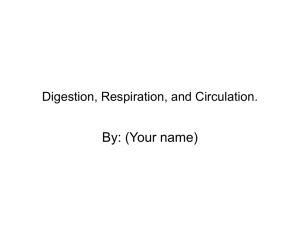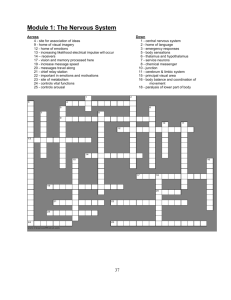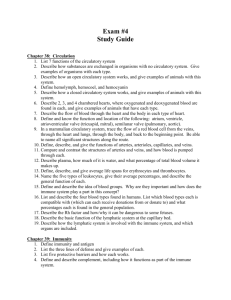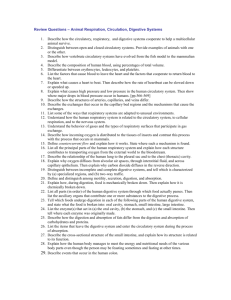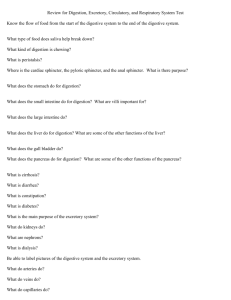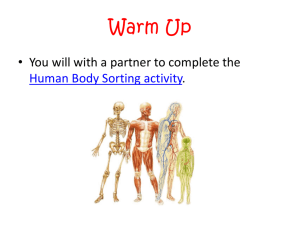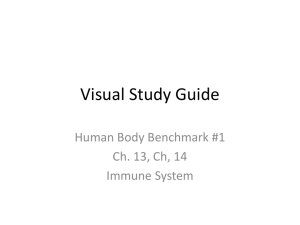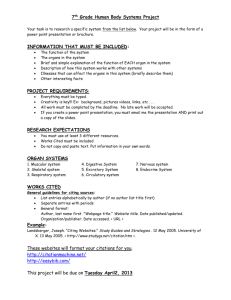Chapters 40-43 - SJDAHomework
advertisement
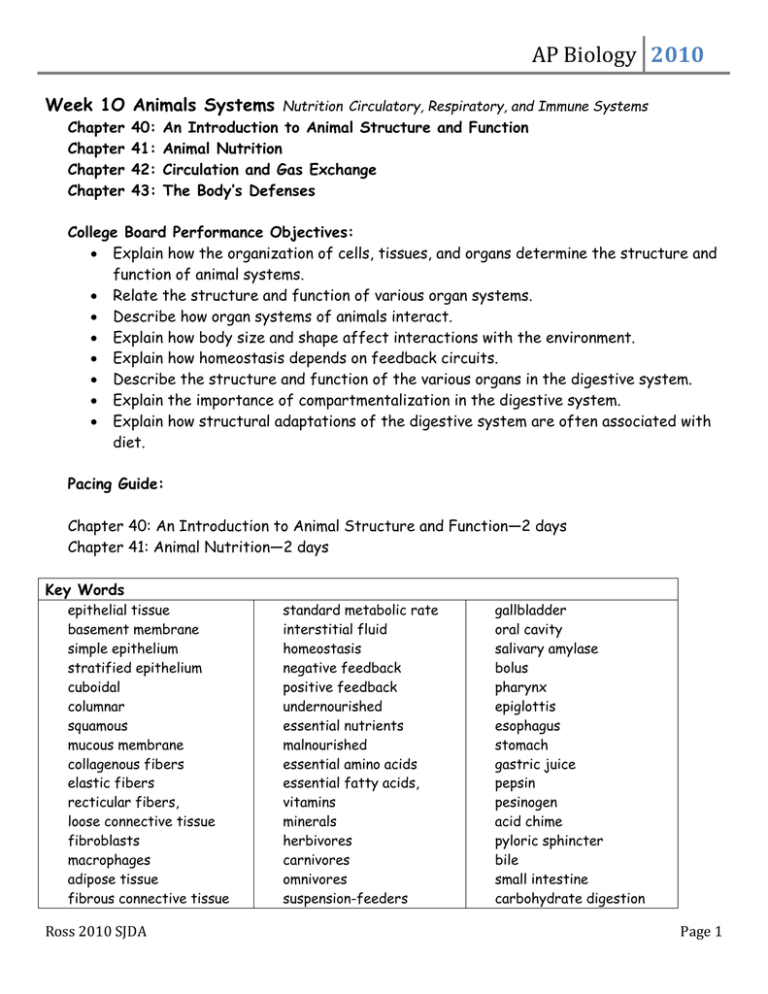
AP Biology 2010 Week 1O Animals Systems Chapter Chapter Chapter Chapter 40: 41: 42: 43: Nutrition Circulatory, Respiratory, and Immune Systems An Introduction to Animal Structure and Function Animal Nutrition Circulation and Gas Exchange The Body’s Defenses College Board Performance Objectives: Explain how the organization of cells, tissues, and organs determine the structure and function of animal systems. Relate the structure and function of various organ systems. Describe how organ systems of animals interact. Explain how body size and shape affect interactions with the environment. Explain how homeostasis depends on feedback circuits. Describe the structure and function of the various organs in the digestive system. Explain the importance of compartmentalization in the digestive system. Explain how structural adaptations of the digestive system are often associated with diet. Pacing Guide: Chapter 40: An Introduction to Animal Structure and Function—2 days Chapter 41: Animal Nutrition—2 days Key Words epithelial tissue basement membrane simple epithelium stratified epithelium cuboidal columnar squamous mucous membrane collagenous fibers elastic fibers recticular fibers, loose connective tissue fibroblasts macrophages adipose tissue fibrous connective tissue Ross 2010 SJDA standard metabolic rate interstitial fluid homeostasis negative feedback positive feedback undernourished essential nutrients malnourished essential amino acids essential fatty acids, vitamins minerals herbivores carnivores omnivores suspension-feeders gallbladder oral cavity salivary amylase bolus pharynx epiglottis esophagus stomach gastric juice pepsin pesinogen acid chime pyloric sphincter bile small intestine carbohydrate digestion Page 1 AP Biology 2010 tendons ligaments cartilage chondrocytes bone osteoblasts Haversian systems blood nervous tissue neuron muscle tissue skeletal muscle striated muscle cardiac muscle smooth muscle organs mesenteries thoracic cavity abdominal cavity organ systems metabolic rate calories kilocalories basal metabolic rate substrate-feeders deposit-feeders fluid-feeders bulk-feeders ingestion digestion enzymatic hydrolysis absorption elimination intracellular digestion extracellular digestion gastrovascular cavities complete digestive tracts alimentary canals anus peristalsis sphincters salivary glands pancreas liver trypsin chymotrypsin carboxypeptidase aminopeptidase dipeptidases teropeptidase nucleases emulsification lipase jejunum ileum villi microvilli lacteal chylomicrons hepatic portal vessel gastrin enterogastrones secretin cholecystokinin large intestine cecum appendix feces Assignment #10 Chapter 41 Animal Nutrition 1. Define ingestion, digestion, absorption, and elimination. 2. Briefly describe digestion in food vacuoles, gastrovascular cavities, and alimentary canals 3. Describe the structure of the walls of the alimentary canal, explain how food moves through the tract, and how it is temporarily held in the stomach before moving to the intestine. 4. Name the four accessory organs of the digestive system. 5. Describe the nature and functions of saliva. What enzyme is present in it? 6. What is the purpose of the epiglottis? Where is it located? 7. What are the functions of the acid and pepsin present in gastric juice. 8. How is the stomach protected from digesting itself? 9. How is the control of acid secretion accomplished? 10. Describe how the structure of the lining of the small intestine relates to it's function. Ross 2010 SJDA Page 2 AP Biology 2010 11. What is the major function of the large intestine? 12. What is the role played by bacteria in the colon? 13. How is dentition related to diet? Part II Circulatory, Respiratory, and Immune Systems Chapter 42: Circulatory and Gas Exchange Chapter 43: The Body's Defenses College Board Performance Objectives: Explain the importance of compartmentalization in the digestive system. Explain how structural adaptations of the digestive system are often associated with diet. Describe the structure and function of the various organs in the circulatory, respiratory, and immune systems. Describe how transport systems functionally connect the organs of exchange with body cells. Explain how vertebrate phylogeny is reflected in adaptations of the cardiovascular system. Explain how gas exchange supplies oxygen for cellular respiration and disposes of carbon dioxide. Explain how antigens react with specific lymphocytes to induce immune response and immunological memory. Explain how helper T lymphocytes function in both humoral and cell-mediate immunity. Pacing Guide: Chapter 42: Circulatory and Gas Exchange—1.5 days Chapter 43: The Body's Defenses—2 days Lab 10 Physiology -1 day Key words open circulatory system hemolymph sinuses closed circulatory system cardiovascular system atrium ventricles arteries Ross 2010 SJDA parabronchi breathing control centers partial pressure respiratory pigments hemocyanin dissociation curve myoglobin lysozymes Page 3 AP Biology 2010 arterioles capillaries capillary beds venules veins pulmocutaneous circuit systemic circuit double circulation pulmonary circuit atrioventricular valve semilunar valves pulse heart rate cardiac cycle systole diastole cardiac output stroke volume sinoatrial node pacemaker atrioventricular node electrocardiogram endothelium blood pressure peripheral resistance lymphatic system lymph lymph nodes plasma red blood cells erythrocytes hemoglobin white blood cells leukocites platelets pluripotent stem cells erythropoietin fibrinogin fibrin hemophilia thrombus cardio vascular disease Ross 2010 SJDA phagocytosis neutrophils macrophages eosinophils natural killer inflammatory response histamines basophiles mast cells prostaglandins chemokines pyrogens complement system interferons B lymphocytes T lymphocytes antigen antibodies antigen receptors T cell receptors effector cells memory cells clonal selection primary immune response plasma cells secondary immune response programmed cell death major histocompatibility complex class I MHC class II MHC antigen presentation cytotoxic T cells helper T cells humoral immunity cell-mediated immunity antigen-presenting cells CD4 cytokines interleukin-2 suppressor T cell CD8 target cell Page 4 AP Biology 2010 heart attack stroke atherosclerosis arteriosclerosis hypertension low-density lipoproteins high-density lipoproteins gas exchange respiratory medium respiratory surface ventilation gills counter-current exchange lungs larynx vocal chords trachea bronchi bronchioles alveoli breathing positive pressure breathing negative pressure breathing diaphragm tidal volume vital capacity residual volume perforin tumor antigen T-dependent antigens T-independent antigens Immunoglobulins heavy chains light chains monoclonal antibodies neutralization opsonization agglutination complement fixation membrane attack complex immune adherence active immunity immunization vaccination passive immunity ABO blood groups Rh factor graft versus host reaction anaphylactic shock acquired immune deficiency syndrome opportunistic diseases human immunodeficiency virus HIV-positive Assignment # 10 Chapters 42 & 43 Chapter 42 Circulation and Gas Exchange 1. Describe the difference between an open and a closed circulatory system. 2. Outline the basic circulatory schemes of vertebrates and explain why the four chambered heart was a necessary evolutionary development in birds and mammals. 3. Distinguish between the five categories of blood vessels 4. Describe the structure of arteries and veins 5. Trace the path of blood through the heart, starting at the vena cava and ending at the aorta; naming all the parts of the heart, blood vessels, and organs it passes through. 6. Explain the terms systemic circuit and pulmonary circuit, identifying the part of the heart that applies to each. Ross 2010 SJDA Page 5 AP Biology 2010 7. Describe the roles of the SA node and AV node in the control of the heart. 8. Explain the relationship between blood flow velocity, blood pressure and cross-sectional area of blood vessels. 9. Explain how blood pressure is measured. 10. Describe how the flow of blood through capillary beds is regulated and how materials are exchanged between capillaries and the interstitial fluid. 11. Name and briefly describe the primary components of blood. 12. Outline the process of blood clotting. 13. Define cardiovascular disease, heart attack, stroke, atherosclerosis, arteriosclerosis, hypertension, LDLs and HDLs. 14. Animals display four basic types of respiratory organs. Describe them. 15. Using the flow of blood through the gill of a fish and the water around it, explain the concept of countercurrent exchange. 16. Briefly describe the structure of the respiratory system, including trachea, bronchi, bronchioles and alveoli. 17. How are vertebrate lungs ventilated? 18. How is breathing controlled in humans? 19. Use the concept of partial pressure to explain the loading and unloading of oxygen and carbon dioxide in the alveolar space and in the tissues. 20. Describe the dissociation curve for hemoglobin and explain how it demonstrates the ability of hemoglobin to deliver oxygen during normal metabolism and during high metabolism. Chapter 43: The Body's Defenses 1. Outline the immune system's three lines of defence. 2. What role is played by the skin and mucous membranes? 3. What role is played by macrophages? 4. What is the job of the natural killer cell? 5. Describe the action of complement system. 6. Describe the inflammatory response. Identify the purpose served by each component of the response. 7. Explain the four components of the immune system. 8. Distinguish between active and passive immunity. 9. What is the key component of the humoral immune system? 10. What is the key component of the cell-mediated immune system? 11. What is an antigen? 12. What is an epitope? 13. Explain how the clonal selection of B cells occurs. 14. What important role is played by memory B cells? Ross 2010 SJDA Page 6 AP Biology 2010 15. Explain the response to a T-dependant antigen (remember, this requires macrophages and TH cells). 16. How is a T cell activated by an APC and what is the result? 17. What are cytokines? 18. Describe the genetic basis for our ability to produce B cells with such a wide range of specificities. 19. Describe the mechanisms by which antibodies function. 20. What is a cytotoxic T cell? How does it work? 21. What is perforin? 22. What are monoclonal antibodies and how can they be used? 23. Describe the antigen/antibody reactions possible in blood transfusions. 24. Why is the immune system an issue in organ transplantation? 25. Describe the allergic response. 26. Explain the transmission, effects, and treatment of HIV and AIDS. Ross 2010 SJDA Page 7
